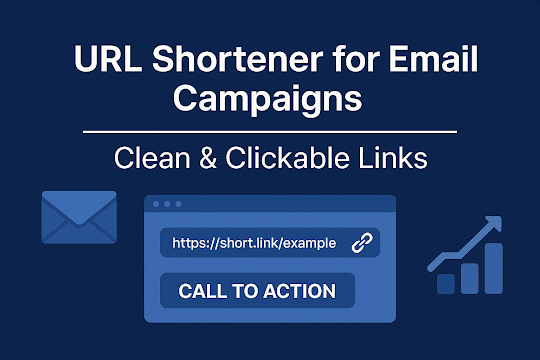📩 Why Use a URL Shortener in Email Campaigns?
Long, messy URLs in email content not only look unprofessional but can also trigger spam filters or break across lines on mobile devices. A URL shortener cleans up your links, making them concise, trackable, and more user-friendly. Whether you're sending a newsletter or a promotional email, shortening your links ensures better engagement and analytics.
🔗 Benefits of Using a Shortened URL in Emails
✅ 1. Clean & Aesthetic Links
Short links look polished and improve the readability of your content, especially in text-heavy email bodies or call-to-action buttons.
📈 2. Click Tracking & Analytics
Monitor who clicks, when, and from where. This helps you:
-
Measure campaign performance
-
Understand audience behavior
-
Optimize future email content
🔐 3. Spam Filter Friendly
Many email clients flag emails with overly long or suspicious-looking URLs. Short links help reduce the risk of emails going to spam.
📱 4. Mobile Compatibility
Short URLs are more responsive and mobile-friendly, ensuring they don’t break in smaller screen layouts or text-based mobile email apps.
🛠️ How to Use a URL Shortener for Email
Step 1: Choose a Reliable URL Shortening Tool
Opt for tools that offer:
-
HTTPS links (for security)
-
Click analytics
-
Custom branding (optional)
Popular tools include:
-
Bitly
-
TinyURL
-
Rebrandly
-
Your own WordPress-based shortener (like Pretty Links)
Step 2: Generate Your Short Link
Paste your original link and get the shortened version. You can often customize the slug (the part after the slash).
Step 3: Insert the Short Link into Your Email
Use it in:
-
Text hyperlinks
-
Call-to-action buttons
-
Email footers
-
Banners
Example:
<a href="https://yourbrand.link/welcome" target="_blank">Get Started Now</a>
🛡️ Best Practices for Email Short Links
-
✅ Use HTTPS for all links
-
✅ Track performance via UTM tags or built-in analytics
-
✅ Avoid generic shorteners for brand-sensitive campaigns
-
✅ Test your links before sending
-
✅ Use descriptive link text, not just the raw URL
📊 Real Use Case
Campaign: "Spring Sale - 50% Off"
Original URL: https://yourstore.com/product-category/spring-sale?ref=email&utm_source=newsletter
Shortened URL: https://yourbrand.link/spring50
Result:
✅ 22% more clicks
✅ 17% higher conversion rate
✅ Fewer spam reports
🎯 Conclusion
Using a URL shortener in email campaigns is a small change with big results. It enhances your email’s visual appeal, improves click-through rates, and provides actionable data. Start shortening your links today for cleaner, clickable, and campaign-ready emails!
